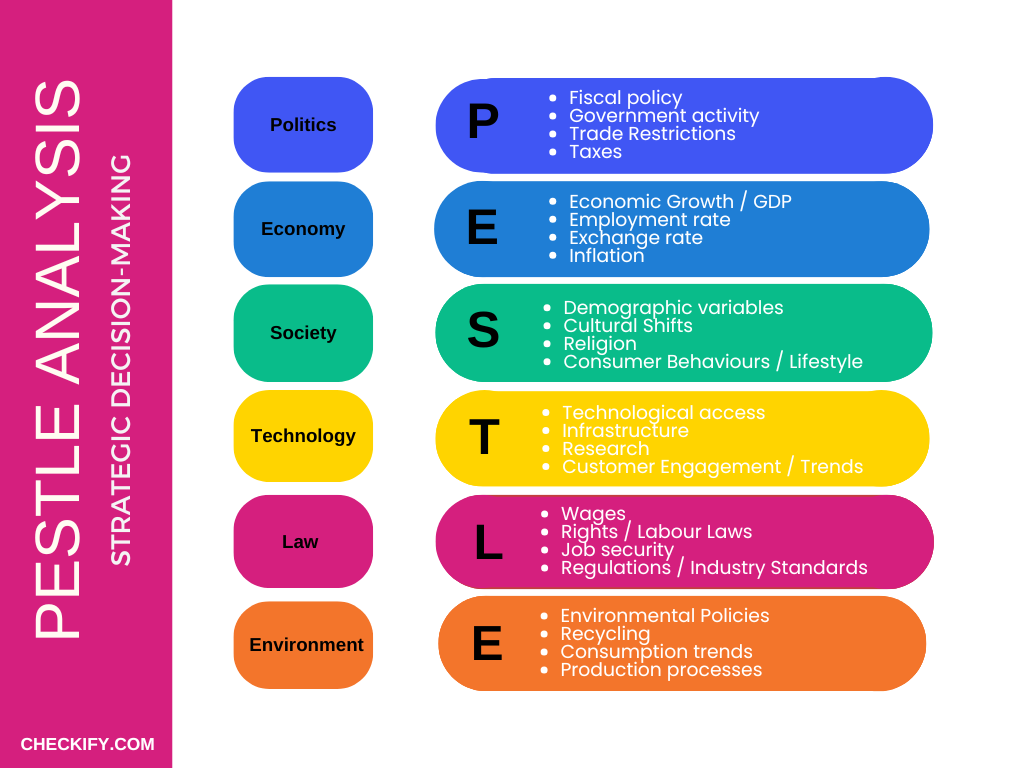Clarify the purpose of the analysis, whether it’s for market entry, product launch, or strategic planning.

PESTLE factors—Political, Economic, Social, Technological, Legal, and Environmental—play a crucial role in shaping the external landscape in which businesses operate. In today’s fast-paced and interconnected world, understanding these factors is essential for making strategic decisions that go beyond the confines of internal operations. Political shifts can reshape regulations, economic trends influence market conditions, and technological advancements drive innovation and disruption. Social dynamics, legal frameworks, and environmental considerations further add layers of complexity to business environments.
PESTLE Analysis offers a structured framework for organisations to identify, analyse, and respond to these external influences. Equipping businesses with insights into the broader context enables them to anticipate changes, seize opportunities, and mitigate risks—ultimately fostering agility, competitiveness, and long-term success.
PESTLE Analysis—a powerful framework that helps organisations anticipate and adapt to external influences.
What is PESTLE Analysis?
PESTLE Analysis is a strategic tool designed to evaluate six critical external factors—Political, Economic, Social, Technological, Legal, and Environmental—that shape the broader business environment. It provides a structured approach to analysing the macro-environment in which an organisation operates, helping businesses to better understand external dynamics that may influence their operations, growth, and long-term strategy.
The 6 Factors of PESTLE analysis
- Political Factors examine government policies, regulations, trade restrictions, and political stability. For instance, changes in tax laws, trade agreements, or political leadership can have profound implications for business operations and strategic process planning.
- Economic Factors focus on variables like inflation rates, exchange rates, economic growth, and unemployment levels. These elements directly impact consumer purchasing power, market demand, and overall profitability.
- Social Factors explore societal trends, cultural shifts, demographic changes, and consumer behaviours. For example, an ageing population or increasing demand for sustainable products can create new market opportunities or challenges.
- Technological Factors analyse advancements and disruptions in technology that can influence production, operations, or customer engagement. Staying ahead of technological trends is vital for maintaining competitiveness in industries driven by innovation.
- Legal Factors address laws and regulations affecting business practices, such as labour laws, consumer protection policies, and industry standards. Understanding these helps organisations maintain compliance and avoid legal disputes.
- Environmental Factors highlight ecological and environmental concerns, including climate change, resource scarcity, and environmental regulations. Businesses are increasingly expected to adopt sustainable practices, making this factor more critical than ever.
By examining each of these areas, businesses gain a 360-degree view of the external forces at play. This analysis helps them identify potential opportunities, such as entering new markets or leveraging emerging technologies, and mitigate risks, such as political instability or regulatory changes.
PESTLE Analysis is not just a one-time exercise—it’s an ongoing process that ensures organisations remain agile and informed in a constantly evolving marketplace. Armed with this knowledge, businesses can craft strategies that align with external realities, enabling them to stay competitive and thrive in the face of uncertainty.
PESTLE Analysis Diagram

Six PESTLE Analysis Examples
Political Factors: Political factors encompass government policies, political stability, taxation laws, trade restrictions, and international relations. These elements can directly influence business operations and profitability.
Example: Changes in trade tariffs might affect the cost of importing raw materials, prompting businesses to reevaluate their supply chain strategies.
Economic Factors: Economic factors include inflation rates, currency fluctuations, interest rates, and overall economic growth. Understanding these trends helps businesses adapt to market conditions.
Example: In a booming economy, increased consumer spending may lead to higher sales, whereas a recession might require cost-cutting measures.
Social Factors: Social factors involve cultural trends, demographic shifts, lifestyle changes, and consumer behaviours. These insights help businesses align their offerings with market needs.
Example: The growing popularity of veganism has spurred food companies to innovate with plant-based alternatives.
Technological Factors: Technological factors refer to innovations, advancements, automation, and the adoption of new digital tools. Staying ahead of technological trends ensures businesses remain competitive.
Example: The integration of artificial intelligence (AI) in customer service is revolutionizing how companies interact with their customers.
Legal Factors: Legal factors cover regulations, labour laws, health and safety standards, and compliance requirements. Ignoring legal considerations can result in penalties or reputational damage.
Example: The introduction of GDPR forced businesses to overhaul their data handling practices to ensure compliance.
Environmental Factors: Environmental factors focus on sustainability, climate change, and eco-conscious consumer trends. Companies increasingly prioritise green practices to meet regulatory and market demands.
Example: Businesses adopting renewable energy solutions to reduce their carbon footprint while appealing to environmentally conscious customers.
Why is PESTLE Analysis Important for Businesses?
PESTLE Analysis is a strategic tool that allows businesses to evaluate the external factors influencing their environment. It is essential because it enables companies to remain agile, competitive, and forward-thinking in a constantly evolving marketplace.
PESTLE Analysis enables businesses to:
- Identify Opportunities: Uncover trends, innovations, and shifts in the external environment that can be turned into growth opportunities. For example:
Technology might open new channels for marketing or operations.
Social trends could highlight changes in consumer preferences, such as the rise in demand for sustainable products.
By keeping a pulse on these factors, businesses can strategically position themselves to harness emerging opportunities. - Anticipate Threats: Mitigate risks posed by external factors. Businesses operate in a landscape fraught with potential challenges, such as new regulations, economic downturns, or changing political climates. Through PESTLE Analysis, you can proactively assess these threats for example:
Legal or regulatory changes may impact compliance and operations.
Environmental concerns, like stricter sustainability requirements, could affect supply chains.
Mitigating these risks before they materialize strengthens resilience and ensures long-term sustainability - Enhance Decision-Making: Align strategies with external changes to remain competitive. A comprehensive understanding of external factors allows businesses to align their strategies with current and anticipated changes. PESTLE Analysis equips decision-makers with insights to:
Marketing tailor campaigns to suit sociocultural changes.
Financial adjust investment plans based on economic forecasts.
This informed approach leads to decisions that are not only timely but also well-calculated, reducing uncertainty and improving outcomes. - Promote Proactive Strategy Development
One of the key advantages of PESTLE Analysis is its ability to shift an organisation’s mindset from reactive to proactive. By forecasting trends and understanding their implications, businesses can adapt swiftly to market conditions, whether that means launching new products, entering untapped markets, or reorganising operations.
By understanding the broader environment, organisations can make proactive rather than reactive decisions.
How to Conduct a PESTLE Analysis
Step-by-Step PESTLE Analysis Checklist
PESTLE Analysis Checklist
PESTLE Analysis and Process Management Tools
Integrating PESTLE Analysis with process management tools can streamline the decision-making process. By using software to track external trends and align them with internal workflows, businesses can:
- Automate data collection and analysis.
- Monitor regulatory changes in real-time.
- Adapt processes quickly in response to external shifts.
Your process management software can serve as the backbone for implementing PESTLE insights, ensuring that strategies are both proactive and agile.
PESTLE Analysis
The Broader Impact
By conducting a PESTLE Analysis, businesses gain a panoramic view of the external environment, encompassing Political, Economic, Social, Technological, Legal, and Environmental factors. This big-picture thinking fosters innovation, enhances agility, and provides a roadmap for navigating complex challenges.
PESTLE Analysis is an indispensable tool for strategic decision-making, providing businesses with the insights needed to navigate an ever-changing landscape. By understanding the external environment, organisations can uncover opportunities, address challenges, and position themselves for long-term success and improved business performance.
Ready to future-proof your business strategies? Discover how our process management software can help you integrate PESTLE insights into your operations seamlessly.
PESTLE is more than just a diagnostic tool—it’s a foundation for strategic growth and adaptability.